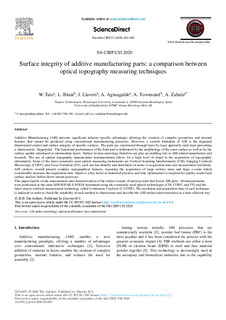| dc.rights.license | Attribution-NonCommercial-NoDerivatives 4.0 International | * |
| dc.contributor.author | Tato, Wilson | |
| dc.contributor.author | Llavori, Inigo | |
| dc.contributor.author | Aginagalde, Andrea | |
| dc.contributor.author | Zabala, Alaitz | |
| dc.contributor.other | Blunt, Liam | |
| dc.contributor.other | Townsend, Andrew | |
| dc.date.accessioned | 2020-06-02T08:24:40Z | |
| dc.date.available | 2020-06-02T08:24:40Z | |
| dc.date.issued | 2020 | |
| dc.identifier.issn | 0000-2012 | en |
| dc.identifier.other | https://katalogoa.mondragon.edu/janium-bin/janium_login_opac.pl?find&ficha_no=158615 | en |
| dc.identifier.uri | https://hdl.handle.net/20.500.11984/1674 | |
| dc.description.abstract | Additive Manufacturing (AM) presents significant industry-specific advantages allowing the creation of complex geometries and internal features that cannot be produced using conventional manufacturing processes. However, a current limitation of AM is the degraded dimensional control and surface integrity of specific surfaces. The parts are constructed through layer-by-layer approach, each layer presenting a characteristic ‘fingerprint’. The functional performance of the final part is influenced by the morphology of the outer surface as well as by the surface quality introduced at intermediate layers. Surface texture metrology therefore can play an enabling role in AM-related manufacture and research. The use of optical topography measurement instrumentation allows for a high level of detail in the acquisition of topographic information. Some of the most commonly used optical measuring instruments are Vertical Scanning Interferometry (CSI), Imaging Confocal Microscopy (CONF), and Focus Variation (FV), each one has benefits and drawbacks in terms of acquisition time and measurement resolution.
AM surfaces overall present complex topographical features, requiring the acquisition of large surface areas and large z-scans which considerably increases the acquisition time. Speed is a key factor in industrial practice, and time optimization is required for quality control and surface analysis before down-stream processes. This paper reports on the measurement and characterisation of the surface texture of metal powder bed fusion AM parts. All measurements were performed in the same SENSOFAR S-NEOX instrument using the commonly used optical technologies (CSI, CONF, and FV) and the latest step in confocal measurement technology called Continuous Confocal (C-CONF). The resolution and acquisition time of each technique is analysed in order to check the suitability of each method to characterize and describe the AM surface microstructures in a time-efficient way. | en |
| dc.description.sponsorship | Engineering and Physical Sciences Research Council EPSRC | en |
| dc.language.iso | eng | en |
| dc.publisher | Elsevier B.V. | en |
| dc.rights | © 2020 The Authors | en |
| dc.rights.uri | http://creativecommons.org/licenses/by-nc-nd/4.0/ | * |
| dc.subject | AM surface metrology | en |
| dc.subject | optical profilometer | en |
| dc.subject | time-optimization | es |
| dc.title | Surface integrity of additive manufacturing parts: a comparison between optical topography measuring techniques | en |
| dcterms.accessRights | http://purl.org/coar/access_right/c_abf2 | en |
| dcterms.source | Procedia CIRP | en |
| local.contributor.group | Tecnologías de superficies | es |
| local.description.peerreviewed | true | en |
| local.identifier.doi | https://doi.org/10.1016/j.procir.2020.02.082 | en |
| local.relation.projectID | Engineering and Physical Sciences Research Council EPSRC/Funding of the Future Metrology Hub/EP-P006930-1/UK// | en |
| local.contributor.otherinstitution | https://ror.org/05t1h8f27 | en |
| local.source.details | Vol. 87. Pp. 403–408, 2020 | eu_ES |
| oaire.format.mimetype | application/pdf | |
| oaire.file | $DSPACE\assetstore | |
| oaire.resourceType | http://purl.org/coar/resource_type/c_6501 | en |
| oaire.version | http://purl.org/coar/version/c_970fb48d4fbd8a85 | en |








